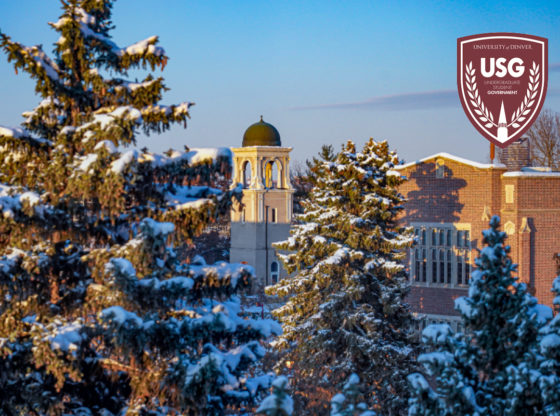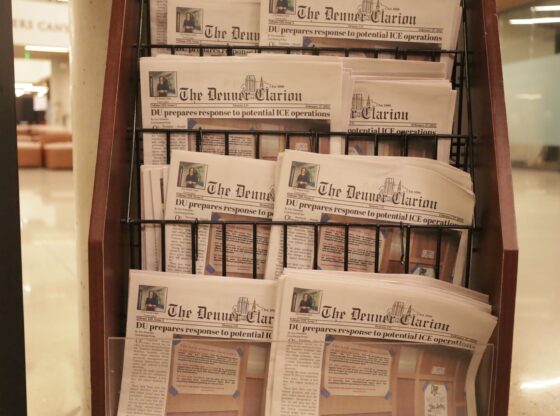This article is part two of a four-part series detailing DU’s efforts to achieve a sustainable campus, considering past and present accomplishments. Now is the critical time to address global warming and the environmental issues that threaten to spiral into worse disasters like the COVID-19 pandemic.
DU has a multitude of buildings certified for Leadership in Energy and Environmental Design (LEED), but what are the specific qualities that make the buildings sustainable?
In an interview with The Clarion, Mark Rodgers answered this question and more nitty-gritty sustainable architecture inquiries. As DU’s campus architect, Rodgers has designed the renovation or reconstruction of every building on campus and is undeniably passionate about his work.
“Here in Denver, there are locally sourced materials that are well aligned with structural and architectural use,” said Rodgers. He and the DU building team worked with the native geographical features and local resources, two fundamental ways to achieve sustainability.
The trucks that transport heavy construction materials burn fossil fuels and contribute to global warming by emitting pollutants and carbon dioxide. Locally-sourced materials do not have to travel as far, reducing the environmental impact of the construction process.
For example, Colorado has a wealth of clay deposits that are used to create bricks. Rodgers utilizes this durable, local material in his sustainable designs.
“We use it for the same reason as the Indigenous community did in their clay adobes,” explained Rodgers. “It holds thermal mass, meaning that it heats up during the day and slowly loses warmth through the night. You don’t necessarily need to use the air conditioner or heater.”
In Margery Reed Hall, Rodgers had to compromise between retaining historical features and achieving modern sustainable standards. He insulated the historic steel windows from the 1920s by attaching new thermoretaining panes onto the interior of the frames with magnets.
The new Burwell Career Center is built with cross-laminated timber (CLT), which is layered to achieve strength and structural integrity. The wood was purchased from sustainable timber companies that replant trees after harvest.
The CLT itself absorbs and stores some of the overabundant atmospheric carbon responsible for global warming. Additionally, the trees grown to replace the harvested materials will also absorb atmospheric carbon and provide oxygen.
Most building materials require extreme heat during the manufacturing processes, burning fossil fuels to create the strength and form. CLT is an alternative that does not.
“It is a much more virtuous cycle than if, for instance, you’re building with concrete,” said Rodgers.
Many of DU’s rooftops and the exteriors of the new buildings feature copper panels because of the material’s effective recyclability; it retains its primary properties like malleability. The recycled copper can also be reused in pipes and electronics.
It has financial incentives as well. Rodgers used the revenue from the recycled copper rooftop of the demolished Driscoll bridge to help pay for the new copper. Not to mention the antimicrobial properties of the copper make it an asset to the campus’ human health during the pandemic, said Rodgers jokingly.
This year, DU has also successfully installed more than 7,000 solar panels onto the rooftops of 18 buildings on campus, including the new Dimond and Burwell buildings. They are currently producing renewable energy and are projected to generate 7-8% of the campus’ energy and reduce the carbon footprint by 3-4%.
Renovation, demolition and reconstruction produce incredible amounts of waste. As much as 40% of America’s landfill waste is generated by construction projects. DU requires its contractors to create at least three different recycling streams to reduce the amount of materials making graves in the landfill, an admirable decision.
A sustainable campus requires more than thoughtful building design. DU’s landscaping must take Colorado’s tough climate into account. The state’s natural vegetation is prairie grass, which has evolved to withstand herds of animals and turbulent seasons.
Rodgers balanced xeriscaping, landscaping that requires little or no irrigation or maintenance, with lawns for student recreation and socialization in his campus design.
DU’s thoughtful campus design and landscaping contributes to the environmental health of the city of Denver as well. Vegetation has a high albedo (ability to reflect solar radiation), but man-made concrete and asphalt surfaces have a low albedo and heat up quickly.
An urban heat island is a problematic bubble of warmth that surrounds cities due to an overabundance of human-made structures like buildings, parking lots and streets. The excessive heat contributes to global warming and photochemical smog which has led to more heat strokes and respiratory concerns in cities.
In an effort to reduce these dangerous heat-retaining surfaces, the Dimond building replaced a parking structure. When complete, the Community Commons building will have a green roof, a space with vegetation that will use rainwater efficiently and not contribute to the urban heat island.
Reduced parking space also incentivizes using one of the many alternative sustainable modes of transportation that reduce emissions associated with single occupancy vehicles (SOVs). The university provides light rail passes, has a bike shop and repair stations around campus and has recently created a shuttle system that uses the Tripshot app. Students can take pride in DU’s commitment to sustainable practices and its manifestations on our beautiful campus. However, there is always room for improvement, and DU’s administration, faculty, staff and students must continue to prioritize long-term sustainability goals.











